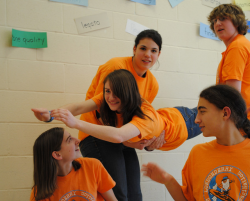 Why do kids and parents keep telling us that joining a Destination Imagination® (or DI) team was one of the best decisions they ever made? What makes this worth the effort?
Why do kids and parents keep telling us that joining a Destination Imagination® (or DI) team was one of the best decisions they ever made? What makes this worth the effort?
DI is fun!
The kids have a blast thinking of imaginative ways to solve our Team Challenges, and getting ready is half the fun! Brainstorming comes first. This is followed by writing, building, gluing and taping, testing and fixing, painting, sewing, and rehearsing.
We celebrate a job well done at Tournaments all over the world. Here thousands of students of all ages and abilities show everyone that DI teams can build nearly anything using cardboard, paint, hot glue, and duct tape! Until you see this for yourself, you’ll never realize just how much kids can accomplish.
Our Tournaments are fun! Teams march in to applause in a big parade for the opening ceremony; the officials wear funny hats; and we have fun and games all day. Silliness is encouraged!
Each team displays their creativity to a cheering crowd. You may not think your child would enjoy performing, tinkering with gadgets, or sewing costumes—but you’ll be surprised when you see the results.
Messages left by team members at the NH-DI State Finals tournament:
- “You’re never shy again after DI, DI ROCKS!”
- “To invent, you need a good Imagination and a pile of JUNK!”
- “Being a team IS what it’s all ABOUT!”
- “In DI, if you’ve made something to be proud of, you’ve already won.”
Rewarding Innovation
When our officials score a team’s solution, the creativity shown by the kids is much more important to us than how well it works.
The highest honor in Destination Imagination is the DaVinci Award, which is given for having a unique approach, for risk taking, or for outstanding creativity—but not for skill or talent, because that’s not what we value most highly.
DI Empowers Kids!
 In Destination Imagination, the kids are in complete control. Our most important rule is that each team has to solve their chosen Team Challenge without outside help, and the adults aren’t allowed to take over.
In Destination Imagination, the kids are in complete control. Our most important rule is that each team has to solve their chosen Team Challenge without outside help, and the adults aren’t allowed to take over.
Here is what the rules say about this:
- The team’s Solution is theirs alone. It is something that the team builds from their acquisition of skills and from their understanding of the Challenge and rules.
- Every idea for every part of your unique solution must come from your team members and team members ONLY. If an idea is offered by someone not on the team, your team may not use that idea, even if you might have thought of it yourselves later on.
- If someone not on your team, such as your Team Manager or a parent, tells your team how to do something, whether you are building something new or just practicing your Presentation, your team must politely tell that person to let you do it yourselves.
Most kids never take complete charge of a big long-term project until they’re much older, because the adults tell them what to do. In DI, these roles are reversed. The kids must make every decision, and the adults act only as facilitators.
We want the adults to teach new skills to every team, but the kids must decide how to use these skills to solve their Team Challenge. The kids are empowered in a way we seldom see in other activities.
“I can’t begin to name the gifts DI has given me. Not only am I armed with lifelong critical skills and surrounded by teammates who became family, I have a confidence that runs deep in my core. At a very young age, when it seems most of what you hear is what you cannot and may not do, my friends and I were told we could do anything and, in fact, what we did do was worthy of a global stage. No matter what obstacles lay in our path or even what walls we may hit, that confidence instilled at such a young age cannot be shaken.”
– Cass Mercer
Teaching Creativity
Many believe that only a few gifted individuals are creative, and the rest of us cannot hope to match their abilities, but this is not true. Both children and adults can learn to be more creative, and anyone who has been involved in DI has seen it happen!
Our kids spend months working on their Team Challenge. They also practice and solve many Instant Challenges. While they are having fun doing this, they are gaining practical experience in creative problem solving—a powerful process based on more than 50 years of research that can transform the way in which children approach problems for the rest of their lives.
Many methods have been proposed to enhance creativity, but much of the research in this area has focused on the Creative Problem Solving Process (CPS). This is a method for generating novel and useful solutions to problems. CPS encourages imaginative thinking at every step in the creative process. Large-scale studies at several major universities have proven its effectiveness. You’ll learn all about CPS if you come to our Team Manager training, because we want every Team Manager to teach their kids to use CPS methods.
“Destination Imagination has, perhaps, had the most influence in my life, after my parents, that is. Nothing else has been such a driving and permanent force as DI. Nothing has driven me to succeed as much like DI. Nothing has driven me to find new and exciting ways to solve problems like DI. Nothing, and I truly mean nothing, has taught me how to work within a team, within a budget, and within a set time, like DI.
I believe that Destination Imagination is one of the best extra-curricular activities for school children. It teaches them so many life skills that other activities may teach in part, but never in whole and never together, and never in such a creative and unique way.
Destination Imagination just makes you a better person.”
-Michael Russell
Learn More
Would you like to learn more about Destination Imagination? Here are some additional resources that might interest you:
Why Destination Imagination? | PDF 600Kb | 3 pages
This white paper explains why Destination Imagination is a must for students, and why business should back this amazing program.
Parents’ Guide | PDF 7Mb
This guide provides an overview of Destination Imagination and its educational goals, a rough timeline for the DI season, an explanation of the Interference rule (which is important for everyone to understand), and an overview of this season’s Team Challenges.
Connecting the Standards | PDF 1.4Mb
Each year, we show how the current season’s Challenges are connected to national educational learning standards. This guide includes a chart to show how each of the learning standards is addressed by our Challenges.
We hope we’ve convinced you that this should be the year when your student will finally get to try DI! If you are already eager to get started, please visit our Start a Team page.
However, if there are still a few things that puzzle you about DI, we have answers for some Frequently Asked Questions.
We hope to see you at the Tournament!
